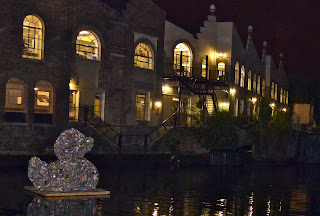With the imminent Olympics and Diamond
jubilee, it seems that Britain has a lot to be proud of this summer. The
growing patriotism of the country makes it no surprise that galleries are
taking up the opportunity to flaunt our creativity and the V&A is no
exception. Christopher Breward and Ghislaine Wood, the curators of the current exhibit,
have focused the showcase between British hosting of the prestigious Olympic games;
from the hard graft of the ‘austerity games’ in 1948 to what promises to be a more
glamorous event in 2012. British Design
1948-2012 follows the ever-changing culture in Britain from post war
renovation to the flourishing technology of modern day, and marks the ways in
which creatives overcome and embrace change to the British lifestyle.
Upon entering the exhibit you are welcomed
with a romantic celebration of Britain’s architectural history in the form of a
section of John Piper’s mural ‘The Englishman’s home’. Sitting majestically beneath the homage of
British construction sits three elegantly designed chairs of the 1950’s,
including Ernst Grace’s marvellous Kangaroo rocking chair, featured greatly in
the Festival of Britain, made from a long single length of steel.
British
Design is separated into three main expanses, each
space giving off a very different ambiance. Initially, we are engrossed in Tradition and Modernity an area that
focuses on the devastating impact of the Second World War and the reconstruction
of British culture. The Festival of Britain in 1951 takes a strong rostrum in
this section, this event, and others such as the coronation of Elizabeth II
were clearly a beacon towards progressive design and lifestyle. This portion of
the exhibit enthusiastically displays the growing concern, in the 50s, of
successful and healthy lifestyle, including sections on the design of
innovative urban planning to ethical living. There’s much to take in Tradition and Modernity and every
spectator is guaranteed to find something of interest, whether it be in the
Harris tweed revival through designers such as Vivienne Westwood, or the
development of the Routemaster bus that stayed functional until 2005.
Succeeding this, we move into the Subversion space, focusing on the
insurgence of British art school students into the creative domain. With the
faint sound of David Bowie overhead, I for one am instantly more settled upon
entering this part of the exhibit. From the influence of artists such as
Hockney, Paolozzi and Hamilton in the Pop era of the 60s to the anarchism of
Punk in the 70s this elating section of the exhibit demonstrates the irreverent
and innovative approaches that sculpted Britain’s cultural landscape. The
influence of the designer on music, fashion and youth culture is displayed
distinctly throughout this section, which truly emphasises how much power creativity
can attain.
With a warm farewell from a gathering of
CSM (Central St Martins) graduate garments, we enter the third and final aspect
of the show, Innovation and Creativity.
At first I am enthused that the first thing I lay my eyes on is a rather
gorgeous Jaguar E-Type, yet as I make my way through the final part of the
exhibition it is clear that the world we live in today is very far from the
world in which I entered the exhibition. Innovation
and Creativity moves away from traditional manufacturing towards the more
recognisable technological design to which we have become accustomed, as is
ultimately a reminder that the social media and gaming are taking over our
lives.
Overall, I would consider the British Design to be a success; the
curators have successfully engaged me into understanding an impressive overview
of 60 years of hardship, revolution and design. Whether it be theatre design,
aeronautical engineering or video games, there will be something you enjoy
displayed in the exhibition. Finding it on the other hand is a different
matter. If anything, I would consider the show to be overwhelming of
information, and really a good afternoon is required to appreciate the
multitudes of work on display. This exhibition is more than design, it is a
homage to the strength and pride of the British in overcoming cultural,
economical an physical strains on our society, and ultimately achieving great
creative solutions to whatever the problem may be.









